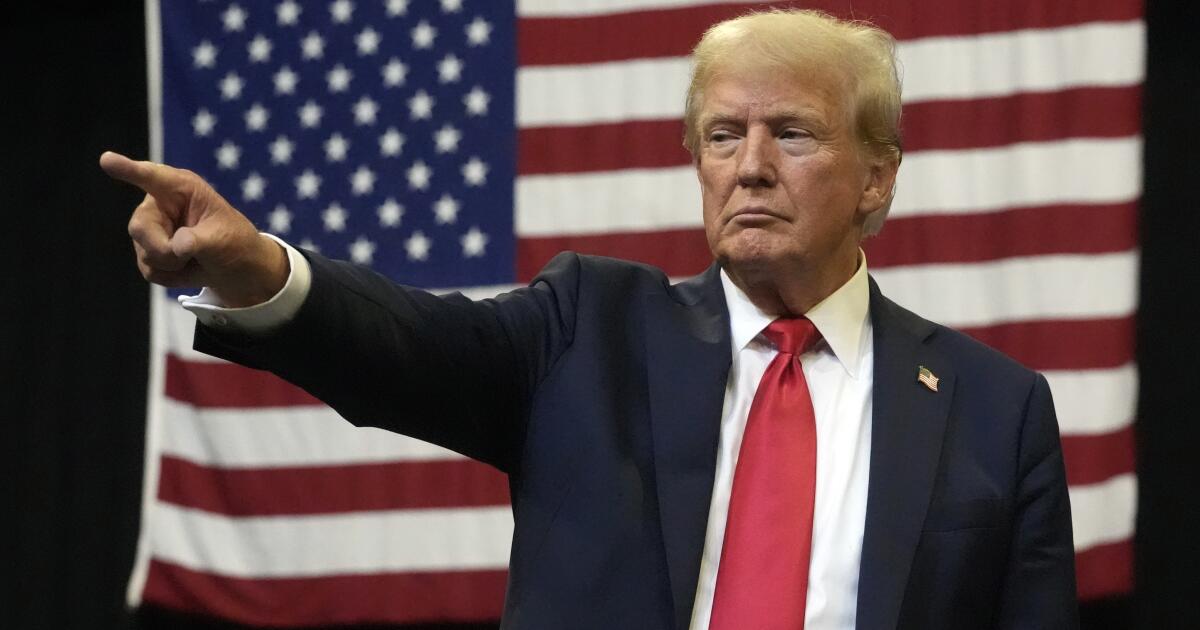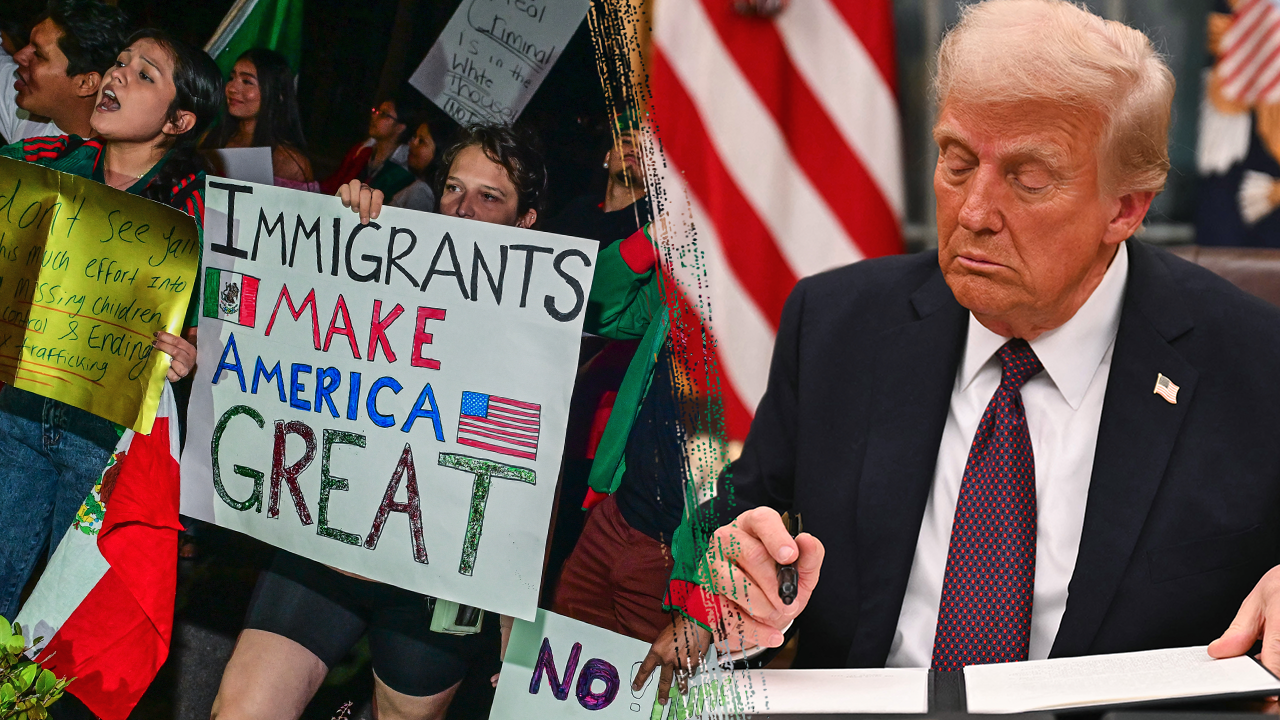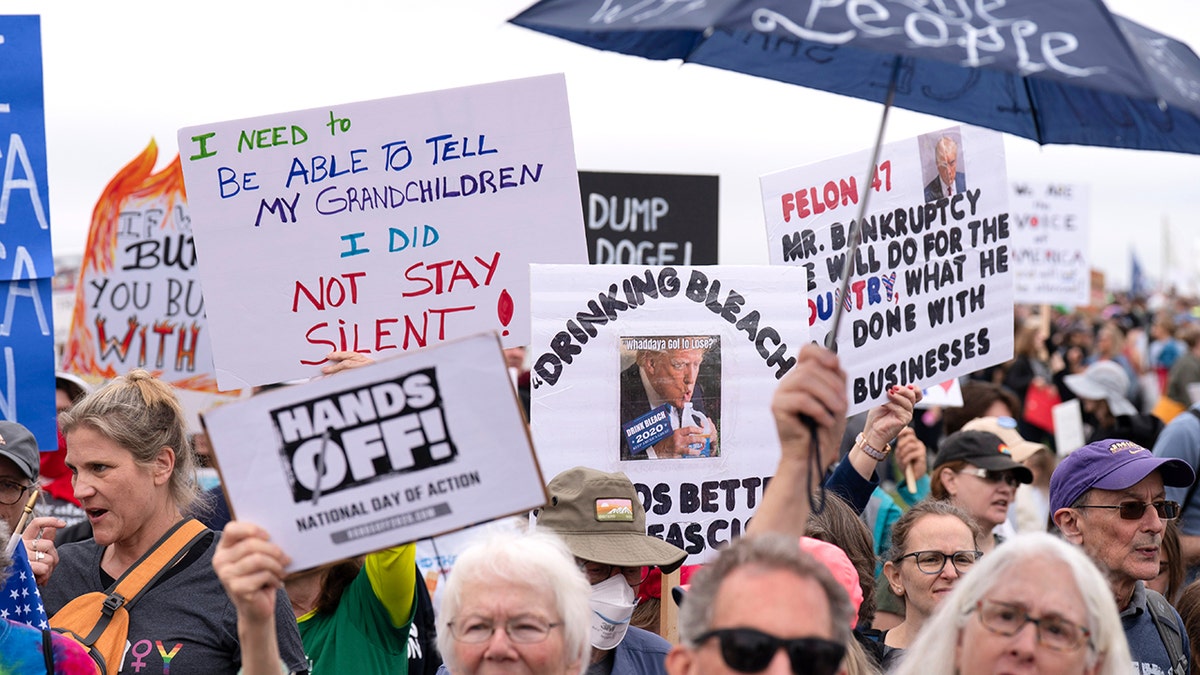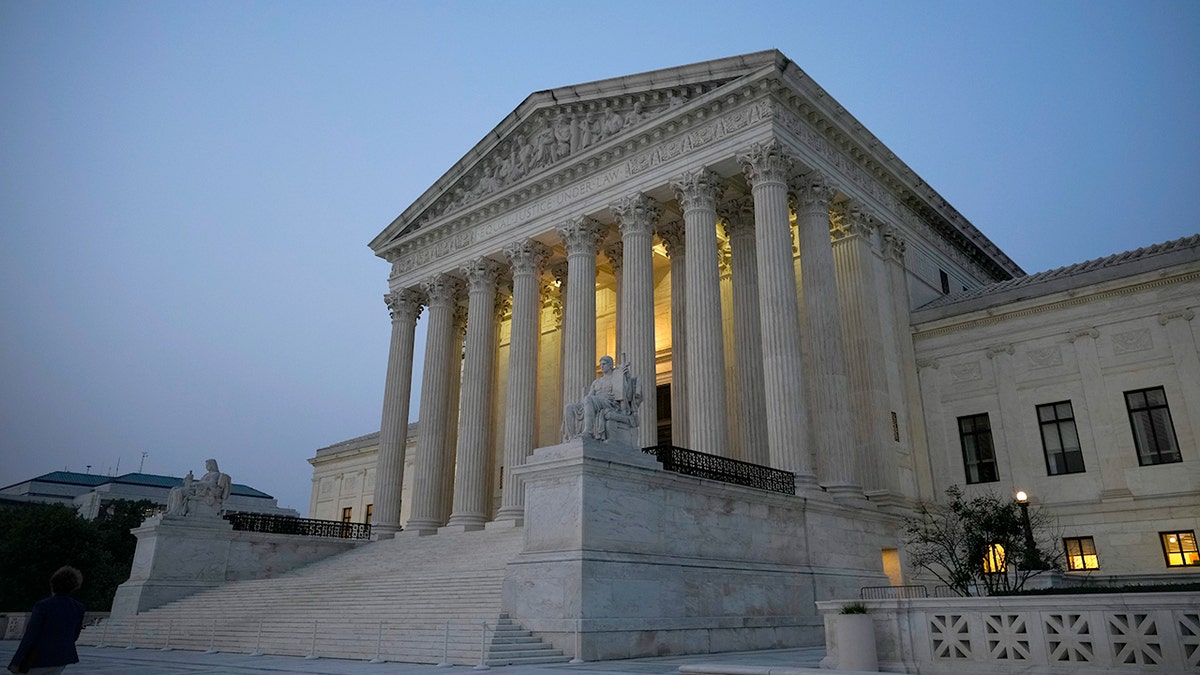Politics
Trump promises to 'save' America with mix of lofty, vague, legally dubious policies

The way former President Trump tells it, the United States is a “crime-ridden mess” with “the worst border in the history of the world,” simultaneously headed for the next Great Depression and World War III.
Also according to Trump, electing him to a second term will change all of that almost immediately. Foreign wars will abruptly end as millions of undocumented immigrants are deported. The U.S. will “DRILL, BABY, DRILL!” and the associated revenue will “rapidly” transform a weak U.S. economy into one where “incomes will skyrocket, inflation will vanish completely, jobs will come roaring back, and the middle class will prosper like never, ever before.”
Trump’s critics say that’s all bluster. They say he’s a showman who speaks in lofty, populist rhetoric, but whose policies portend the opposite of his promises. Rather than America’s savior, they say, he would be its destroyer.
They note Trump has admitted he would act like a “dictator” on “Day One,” and warn that multiple conservative playbooks for his next term — including Project 2025 and Trump’s own Agenda 47 — suggest a full-scale adoption of authoritarianism.
They believe Trump would dismantle social safety nets for the poor and middle class, illegally discriminate against vulnerable groups such as LGBTQ+ people, and reduce the rights of women, including to reproductive healthcare. Empowered by a recent Supreme Court ruling granting presidents sweeping immunity, they fear, the twice-impeached, criminally convicted former president who helped incite an insurrection the last time he lost an election would be unleashed — and unhinged — if he wins.
The one thing Trump loyalists and critics agree on is that the candidate has said quite a lot about what he plans to do. How they feel about him often comes down to how they feel about those promises — many lofty, vague or legally dubious — and whether they take him at his word or believe he’s lying.
On immigration
Trump has been heavily focused on immigration, claiming an “invasion” of murderers, terrorists, “insane asylum” patients and fentanyl-smuggling gang members along the Mexico border.
Trump has said he will “seal the border” with a physical wall, finishing a job he prioritized during his first term, and “carry out the largest deportation operation in American history.” He has promised to punish so-called sanctuary cities that don’t coordinate with federal immigration enforcement and to deport immigrants without considering asylum claims.
Trump has said he will order his military to attack foreign drug cartels, and seek the death penalty for “drug dealers, kingpins and human traffickers.” He has also said that on his first day in office, he will issue an executive order doing away with birthright citizenship — contradicting long-established constitutional precedent by simply declaring that the “correct interpretation” of the law is that U.S. citizenship is not granted to everyone born on U.S. soil.
Chris Zepeda-Millán, an associate professor of public policy, Chicana/o studies and political science at UCLA, is co-author of “Walls, Cages, and Family Separation: Race and Immigration Policy in the Trump Era.”
His research has found most Americans did not support Trump’s first-term immigration policies, especially those that separated kids from their families, and do not believe a border wall would be effective. Zepeda-Millán said those who supported Trump’s policies — sometimes despite believing them to be ineffective — also held the “most racist views,” including general discomfort with growing Latino populations.
Trump’s hyper focus on immigrants today is an “anti-Latino symbolic action” aimed at those same people, Zepeda-Millán said — his way of “doubling down on getting the most racist white Americans out to vote.” Trump leads Vice President Kamala Harris in recent polls on who would handle immigration better, including 51% to 46% in a New York Times/Siena College poll of key swing states.
Trump can be counted on to continue using racism to win political points, Zepeda-Millán said, but he doubts Trump will actually try to deport millions of people, many of whom would be farmworkers. “Everyone knows — including Trump — that significant parts of our economy are completely dependent on not only immigrants, but undocumented immigrants,” he said.
On abortion
When Trump ran for president in 2016, he campaigned on overturning the federal right to an abortion under Roe vs. Wade. As president, Trump appointed three of the six conservative Supreme Court justices who would overturn Roe in 2022, ushering in a wave of state abortion restrictions and bans.
Reproductive healthcare advocates have blamed Trump for decimating those rights, which most Americans support, and Harris has campaigned on restoring them.
In response, Trump has tried to walk a fine line on the issue, in part by dodging questions or answering them vaguely. He has taken credit for dismantling Roe and returning the power to restrict abortion to individual states, but resisted calls for a nationwide abortion ban. He has said he personally supports exceptions for abortion in cases of rape and incest and when a woman’s life is in danger, but also left the door open to further restrictions on commonly used abortion pills.
Arneta Rogers, executive director at the Center on Reproductive Rights and Justice at Berkeley Law School, said Trump paved the way for extreme antiabortion laws that are disproportionately harming people living “on the margins” — including people of color and the young, poor and queer — and should be made to own that legacy, because “the stakes couldn’t be higher.”
“When people show you who they are, you have to believe them,” Rogers said.
On the economy
Trump has promised to stop taxing Social Security income for seniors, and to stop taxing tips received by service workers. Both promises would cost the government billions, though the exact price tag is unknowable without more specifics. Harris has also pledged to work to end federal tax on tips.
Trump has said he would pay for his agenda by increasing domestic energy production through drilling and driving down fuel costs, by striking better trade deals with foreign countries and implementing tariffs on those that don’t fall in line, and by eliminating waste in the federal bureaucracy.
Blaming inflation in part on “unnecessary spending” by President Biden, Trump has said he would use a special “impoundment” authority — which presidents do not legally have — to withhold “large chunks” of each federal agency’s budget, regardless of how Congress allocated the funding. He has promised to eliminate the U.S. Department of Education.
Susan Minato, co-president of Unite Here Local 11, a union representing service workers across Southern California and Arizona, called Trump’s promise to end taxes on tips a “red herring” that workers recognize as a distraction from his long record of attacking union labor and the Affordable Care Act, which provides many wage earners with vital healthcare.
“Our members see straight through it,” she said — and are spreading out across Arizona, a key swing state, to knock on doors and talk to working voters about Harris being a better option for the working class.
On the climate
Trump has promised to dismantle environmental programs and increase drilling for oil and gas.
Trump has ridiculed wind power as “weak” and electric vehicles as too expensive, and suggested a turn back to fossil fuels will rapidly reduce energy costs. He has promised to withdraw funding from clean energy initiatives under the so-called Green New Deal, ridiculing it as the “Green New Hoax.”
Project 2025 has rejected the threat of global warming outright, calling for the National Oceanic and Atmospheric Administration, which includes the National Weather Service, to be dismantled as “one of the main drivers of the climate change alarm industry.”
On Ukraine and Gaza
During his speech at the Republican convention last month, Trump said, “I don’t have wars,” that he “could stop wars with just a telephone call,” and that the wars in Ukraine and Gaza never would have started were he president.
The U.S. was at war in Afghanistan when Trump was president.
After a call with Ukrainian President Volodymyr Zelensky last month, Trump said he would end the war in Ukraine by convincing Zelensky and Russian President Vladimir Putin — who ordered the invasion of Ukraine in 2022 — to “negotiate a deal.”
Trump has repeatedly professed his support for Israel’s war in Gaza, which has devastated civilian populations, and said that any Jewish person considering voting for Harris “should have their head examined.” Agenda 47 says Trump will “deport pro-Hamas radicals” from the U.S. and make college campuses — the site of many pro-Palestinian demonstrations — “safe and patriotic again.”
Trump has also said he would build an “Iron Dome” over the entire U.S., referring to Israel’s short-range antimissile defense system. Experts have said building such a system in the U.S. would not make sense given the nation’s size, geographic position and existing defense capabilities, but allowed that Trump may be using the familiar name of Israel’s system as a “metaphor” for a more complex antimissile defense system in the U.S.
The U.S. is threatened by unmanned aerial systems, cruise missiles and other weapons systems, said Tom Karako, a missile defense analyst at the Center for Strategic and International Studies, and is already in the process of building out its defenses.
The Trump campaign did not respond to questions from The Times on the above policy areas.

Politics
Contributor: The Israeli Embassy killings and the ominous turn in political violence

Actions, we know, have consequences. And an apparent Marxist’s cold-blooded murder of two Israeli Embassy staffers in Washington on Wednesday night was the natural and inevitable consequence of a conscientious, years-long campaign to dehumanize Jews and otherize all supporters of the world’s only Jewish state.
Seriously, what did you think was going to happen?
Some of President Trump’s more colorful all-caps and exclamation-mark-filled social media posts evince an impending jackboot, we’re sometimes told. (Hold aside, for now, columnist Salena Zito’s apt 2016 quip about taking Trump seriously but not literally.) Words either have meaning or they don’t. And many left-wing Americans have, for a long time now, argued that they have tremendous meaning. How often, as the concept of the “microaggression” and its campus “safe space” corollary took off last decade, were we told that “words are violence”? (I’ll answer: A lot!)
So are we really not supposed to take seriously the clear calls for Jewish genocide that have erupted on American campuses and throughout American streets since the Hamas pogrom of Oct. 7, 2023? Are we really supposed to believe that chants such as “globalize the intifada,” “from the river to the sea, Palestine will be free” and “there is only one solution, intifada revolution” are vague and open to competing interpretations?
That doesn’t even pass the laugh test.
When pro-Israel Jewish American Paul Kessler died after being hit on the head during a clash of protesters in Thousand Oaks on Nov. 5, 2023, that is what “intifada revolution” looks like in practice. When Israeli woman Tzeela Gez was murdered by a jihadist while en route to the hospital to deliver her baby earlier this month, that was what “from the river to the sea” looks like in practice. And when two young Israeli Embassy staffers were executed while leaving an event this week at Washington’s Capital Jewish Museum, that is what “globalize the intifada” looks like in practice.
Really, what did you think was going to happen?
Indeed, it is the easily foreseeable nature of Wednesday night’s slayings that is perhaps the most tragic part of it all. The suspect in the deaths of Yaron Lischinsky and Sarah Milgrim left behind a handy manifesto laying out a clear political motivation. This was not a random drive-by shooting. Hardly. This was a deliberate act — what appears to be an act of domestic terrorism. And the suspect, Elias Rodriguez, has a long history of involvement in far-left activist causes. If the killer intended to target Jews, then the fact that both victims were apparently Christian only underscores the “globalize” part of “globalize the intifada.”
Zito had it right back in 2016: Trump’s social media posts should be taken seriously, not literally. But when it comes to the murderous, genocidal clamoring for Jewish and Israeli blood that has become increasingly ubiquitous ever since the Jews themselves suffered their single bloodiest day since the Third Reich, such anti-Israel and antisemitic words must be taken both seriously and literally.
A previous generation of lawmakers once urged Americans to fight the terrorists “over there” so that they can’t harm us “here.” How quaint! The discomfiting reality in the year 2025 is this: The radicals, both homegrown and foreign-born alike, are already here. There are monsters in our midst.
And those monsters are not limited to jihadists. Domestic terrorists these days come from all backgrounds. The deaths of two Israeli diplomats are yet another reminder (not that we needed it): Politically motivated violence in the contemporary United States is not an equivalent problem on both the left and the right.
In 2012, Floyd Lee Corkins attempted to shoot up the socially conservative Family Research Council because he heard it was “anti-gay.” In 2017, James Hodgkinson shot up the Republican congressional baseball team a few weeks after posting on Facebook that Trump is a “traitor” and threat to “our democracy.” In 2022, Nicholas Roske flew cross-country to try to assassinate Supreme Court Justice Brett Kavanaugh and thus prevent Roe vs. Wade from being overturned. Earlier this year, anti-Elon Musk activists burned and looted Teslas — and assaulted Tesla drivers — because of Musk’s Trump administration work with his cost-cutting Department of Government Efficiency. And who can forget Luigi Mangione, who is charged in the shooting death of UnitedHealthcare Chief Executive Brian Thompson?
Both “sides” are not culpable here. They just aren’t. Israel supporters in America aren’t out there gunning down people waving the PLO flag. Nor are capitalists out there gunning down socialists.
There is a real darkness out there in certain — increasingly widespread — pockets of the American activist left. Sure, parts of the right are also lost at the moment — but this is not an apples-to-apples comparison.
Regardless, the violence must end. And we must stop treating open calls for murder or genocide as morally acceptable “speech.” Let’s pull ourselves back from the brink before more blood is shed.
Josh Hammer’s latest book is “Israel and Civilization: The Fate of the Jewish Nation and the Destiny of the West.” This article was produced in collaboration with Creators Syndicate. @josh_hammer
Insights
L.A. Times Insights delivers AI-generated analysis on Voices content to offer all points of view. Insights does not appear on any news articles.
Viewpoint
Perspectives
The following AI-generated content is powered by Perplexity. The Los Angeles Times editorial staff does not create or edit the content.
Ideas expressed in the piece
- The article argues that the killings of two Israeli Embassy staffers were a “natural and inevitable consequence” of widespread anti-Semitic rhetoric and the dehumanization of Jews since the October 7 Hamas attacks, citing officials who labeled the shooting an “act of terror”[1][3].
- It links the attack to pro-Palestinian chants like “globalize the intifada” and “from the river to the sea,” asserting these phrases are explicit calls for violence rather than protected political speech[1][3].
- The author claims political violence in the U.S. is disproportionately perpetrated by the far left, citing historical examples such as the 2012 Family Research Council shooting and the 2022 attempted assassination of Justice Brett Kavanaugh[3].
- Hammer emphasizes that the suspect’s far-left activism and manifesto reveal a deliberate, ideologically motivated act of domestic terrorism, underscoring a broader trend of anti-Israel radicalization[1][3].
Different views on the topic
- Critics caution against broadly attributing isolated violent acts to entire political movements, noting that most activists condemn violence while advocating for Palestinian rights through nonviolent means[1][2].
- Some argue that condemnations of Israeli government policies should not be conflated with anti-Semitism, emphasizing the distinction between criticizing a state and targeting a religious group[1][3].
- Legal experts highlight that while the attack was labeled antisemitic, the victims’ identities as non-Jewish Israeli staffers complicate narratives framing the shooting solely as religiously motivated hatred[1][2].
- Advocates for free speech warn against equitating protest chants with incitement, stressing the importance of contextualizing rhetoric to avoid suppressing legitimate political dissent[1][3].
Politics
How Donald Trump Has Remade America’s Political Landscape
Politics
Upending US birthright citizenship would have drastic negative impact, defenders warn

The Supreme Court heard a case this month centered on President Donald Trump’s executive order seeking to end so-called birthright citizenship, in one of the most closely watched and potentially impactful cases heard by the court in recent years.
Though the case itself was used largely as a means of challenging lower court powers to issue so-called universal or nationwide injunctions, justices on the high court did inquire about the merits of the order itself, “Protecting the Meaning and Value of American Citizenship,” which Trump signed on the first day of his second White House term.
The order, which was slated to take force Feb. 20, directed all U.S. agencies to stop issuing citizenship documents to children born to illegal immigrants or children born to mothers living in the country on a temporary visa, if the father is not a permanent resident or U.S. citizen.
Despite the Supreme Court’s focus on universal injunctions in hearing the case, deep and unyielding concerns persist about Trump’s attempt to undo more than 100 years of legal precedent.
JUDGES V TRUMP: HERE ARE THE KEY COURT BATTLES HALTING THE WHITE HOUSE AGENDA
U.S. President Donald Trump shakes hands with U.S. Supreme Court Chief Justice John Roberts (R) as Melania Trump, Donald Trump Jr. and Ivanka Trump look on after being sworn in during inauguration ceremonies in the Rotunda of the U.S. Capitol on January 20, 2025, in Washington, D.C. Chip Somodevilla/Pool via Reuters/File Photo (Reuters)
The ACLU included in its lawsuit the story of one couple from Indonesia but living in New Hampshire whom they said would be affected by the order.
“They arrived in 2023, applied for asylum, and their application awaits review,” ACLU attorneys said of the couple. “The mom-to-be is in her third trimester.
“Under this executive order, their baby would be considered an undocumented noncitizen and could be denied basic health care and nutrition, putting the newborn at grave risk at such a vulnerable stage of life,” they added.
And such problems would persist throughout their lives, lawyers for the group noted. These persons would not be able to obtain necessary identification, such as drivers’ licenses, and would not be able to vote, hold some jobs or serve on juries.
Though Trump had spoken in detail in his first term and on the campaign trail about wanting to end birthright citizenship, his executive order sent shockwaves through the nation. It was met by a wave of lawsuits from Democrat-led states and immigrants’ rights groups.
WHO IS JAMES BOASBERG, THE US JUDGE AT THE CENTER OF TRUMP’S DEPORTATION EFFORTS?

Demonstrators hold up signs during a “Hands Off!” protest against President Donald Trump at the Washington Monument in Washington, Saturday, April 5, 2025. (AP Photo/Jose Luis Magana)
One lawsuit, brought by 18 Democratic attorneys general, warned that ending birthright citizenship would strip hundreds of thousands of U.S.-born children of their citizenship as the result of a circumstance completely outside a child’s control.
Statistics also bear this out. Roughly 150,000 children are born annually in the U.S. to parents of noncitizens. If the order were to take force as Trump envisioned, experts warned the impact would be catastrophic.
”President Trump’s attempt to unilaterally end birthright citizenship is a flagrant violation of our Constitution,” New Jersey Attorney General Matthew Platkin, who joined 17 other Democrat-led states in suing to block the order, said earlier this year.
TRUMP FACES ANOTHER DEPORTATION SETBACK WITH 4TH CIRCUIT APPEALS COURT

The U.S. Supreme Court is at the center of fresh debate over the interpretation of a core clause of the Fourteenth Amendment. (Drew Angerer/Getty Images)
“For more than 150 years, our country has followed the same basic rule: Babies who are born in this country are American citizens,” Platkin added.
More than 22 U.S. states and immigrants’ rights groups sued the Trump administration to block the change to birthright citizenship prior to the Supreme Court’s decision to take up the case, arguing in court filings that the executive order is both unconstitutional and “unprecedented.”
To date, no court has sided with the Trump administration in upholding the executive order.
-

 Technology1 week ago
Technology1 week agoMeta asks judge to throw out antitrust case mid-trial
-

 World1 week ago
World1 week agoCommissioner Hansen presents plan to cut farming bureaucracy in EU
-

 News1 week ago
News1 week agoNew Orleans jailbreak: 10 inmates dug a hole, wrote ‘to easy’ before fleeing; escape plan found
-

 News1 week ago
News1 week agoVideo: Doctors Heal Infant Using First Customized-Gene Editing Treatment
-

 Movie Reviews1 week ago
Movie Reviews1 week agoDevil’s Double Next Level Movie Review: Trapped in a punchline purgatory
-

 Business1 week ago
Business1 week agoVideo: How Staffing Shortages Have Plagued Newark Airport
-

 Business1 week ago
Business1 week agoConsumers Show Signs of Strain Amid Trump's Tariff Rollout
-

 Movie Reviews1 week ago
Movie Reviews1 week ago‘Nouvelle Vague’ Review: Richard Linklater’s Movie About the Making of Godard’s ‘Breathless’ Is an Enchanting Ode to the Rapture of Cinema













